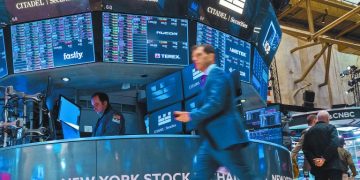Introduction
In recent years, renewable energy has emerged as one of the most compelling sectors for investors worldwide. As global concerns over climate change intensify, governments, companies, and investors are increasingly focused on clean and sustainable energy sources. Among the various financial markets where renewable energy companies are making their mark, Australia’s Australian Securities Exchange (ASX) has risen in prominence. As the ASX becomes a critical hub for green energy investment, it is essential to explore its significance, the rising presence of renewable energy companies, the investment opportunities in the sector, and the risks and challenges involved. This article will delve into these areas, analyzing how the ASX is positioning itself as a key player in the Asia-Pacific region’s transition to renewable energy, and whether it offers a haven for investors looking to tap into the burgeoning green energy market.
1. Overview of the ASX and Its Significance in the Asia-Pacific Region
The Australian Securities Exchange (ASX) is one of the largest stock exchanges in the Asia-Pacific region. Established in 1987, the ASX is a prominent player in the global financial market, with over 2,200 companies listed, including some of the world’s largest corporations. The exchange operates in diverse sectors, including finance, resources, healthcare, and technology, but in recent years, the ASX has seen an increasing focus on renewable energy. The ASX plays a crucial role in connecting Australian companies with global investors, particularly in the Asia-Pacific region. As the demand for renewable energy increases across the globe, Australia’s natural resources, clean energy policies, and technological advancements position the country as a key player in the green energy transition. Australia’s geographic proximity to Asia—one of the world’s largest energy markets—further solidifies the ASX as a central hub for investments in renewable energy within the region. The Australian government has also taken a proactive approach in supporting the renewable energy sector, through policy measures aimed at reducing carbon emissions and promoting sustainable development. In 2021, Australia announced its commitment to achieving net-zero emissions by 2050, a move that has significantly boosted investor confidence in the renewable energy market. The government has incentivized the development of clean energy projects by offering subsidies, tax incentives, and grants to renewable energy companies.
2. The Rising Presence of Renewable Energy Companies on the ASX
The rise of renewable energy companies on the ASX is part of a global trend toward more sustainable energy practices. Over the past decade, Australia has seen a significant increase in the number of renewable energy companies listing on the ASX. These companies span various segments of the renewable energy sector, including solar, wind, hydropower, geothermal, and energy storage. Australia’s vast land area and abundant sunshine make it one of the most favorable markets for solar energy projects. Companies involved in solar panel manufacturing, solar farms, and solar technology innovations are seeing significant growth on the ASX. Some notable Australian solar energy companies include First Solar, RedFlow, and Solgen Energy Group. With Australia aiming to increase its renewable energy capacity, solar companies listed on the ASX are experiencing steady demand from investors seeking long-term growth opportunities. In the wind energy sector, Australia’s favorable geography and government support for wind power projects have contributed to the rise of companies like Infigen Energy and Tilt Renewables on the ASX. These companies are at the forefront of developing large-scale wind farms, which are essential for meeting Australia’s renewable energy targets. Additionally, hydropower and energy storage solutions are gaining traction as critical components of the renewable energy transition. Companies such as Hydro Tasmania and Genex Power are making significant advancements in energy storage technologies, particularly pumped hydro projects, which address the intermittency challenges of renewable energy sources.

3. Investment Opportunities in Green Energy Stocks and ETFs
The ASX offers a wide range of investment opportunities in the renewable energy sector, from individual green energy stocks to exchange-traded funds (ETFs) focused on clean energy. These options provide investors with the flexibility to tailor their portfolios based on their risk tolerance, investment goals, and sector preferences. Individual green energy stocks represent companies directly involved in renewable energy production, storage, and distribution. For example, Aurelia Metals is a leading player in clean energy materials, while Mercury NZ focuses on geothermal energy production. Investors who prefer a diversified approach can opt for green energy ETFs listed on the ASX. These ETFs pool investments across multiple renewable energy companies, reducing the risks associated with individual stock performance. Notable ETFs include the BetaShares Climate Change Innovation ETF (ERTH), which invests in global companies driving innovation in clean energy and sustainable technologies, and the VanEck Global Clean Energy ETF (CLNE), which tracks the performance of clean energy companies worldwide. For those seeking exposure to both domestic and international markets, these ETFs provide an attractive entry point into the renewable energy sector.
4. Risks and Challenges in the Australian Renewable Sector
While the renewable energy sector in Australia offers immense potential, it is not without risks and challenges. Investors must carefully consider these factors before committing their capital to green energy stocks or ETFs. One significant challenge is the intermittency of renewable energy sources, such as solar and wind power. Unlike traditional energy sources, renewables depend on weather conditions, which can lead to fluctuations in energy production. While advancements in energy storage technology are helping to mitigate this issue, the cost of implementing large-scale storage solutions remains high. Regulatory uncertainty also poses a risk to the renewable energy sector. Changes in government policies, subsidies, and tax incentives can have a direct impact on the profitability of renewable energy projects. For example, a shift away from favorable clean energy policies could reduce investor confidence and slow down the growth of the sector. Additionally, the renewable energy market is highly competitive, with many companies vying for a share of the market. This intense competition can lead to price wars, reduced profit margins, and increased pressure on smaller companies to innovate and scale quickly. Finally, geopolitical and economic factors, such as trade tensions and global supply chain disruptions, can affect the availability of critical materials needed for renewable energy projects. The recent global shortage of semiconductors and rare earth metals is a prime example of how external factors can impact the renewable energy sector.
Conclusion
The ASX has emerged as a promising hub for renewable energy investments, offering a diverse range of opportunities for investors seeking exposure to the green energy sector. With a growing presence of renewable energy companies, supportive government policies, and an increasing focus on sustainability, the ASX is well-positioned to become a key player in the global transition to renewable energy. However, investors must also be mindful of the risks and challenges inherent in the sector, including intermittency issues, regulatory uncertainty, and supply chain disruptions. By conducting thorough research and leveraging tools such as ETFs, investors can navigate these challenges and potentially benefit from the long-term growth prospects of renewable energy on the ASX. As the world continues its shift toward cleaner energy, Australia’s ASX may indeed prove to be a haven for renewable energy investments.





































